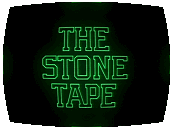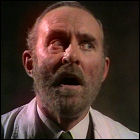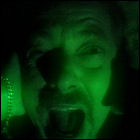 An abandoned pre-war building is taken over by Ryan Electronics to serve as the skunkworks for a crash program to find and develop the electronic recording medium that will supplant magnetic tape. With its wartime history as a command post for visiting American soldiers, and an even longer history as a haunted house stretching back into the late 1800s, the building isn’t anyone’s favorite place. Some members of the electronics R&D team refuse to work there, and a visit to the pub reveals that the locals believe that any new secret project there is military (and hazardous) in nature. The sole female member of the Ryan Electronics team, Jill, experiences a vision in a supply room formerly used by the U.S. Army, catching a fleeting glimpse of a screaming woman, and project director Peter isn’t convinced until he hears the screaming for himself. Determined to debunk the hauntings so his team can get down to their real work, Peter decides to throw the team’s resources at the problem, using every kind of sensing and recording equipment at their disposal and regarding the sightings as merely misinterpreted data. Even though sightings continue, none of the group’s equipment manages to record any of it. After several further sightings, Peter becomes convinced that the sightings are a message recorded in the very stones of the building itself, a “stone tape” recorded by a massive output of psychic energy, though the haunting nature of the repeated sightings gives his team the uncomfortable feeling that the burst of energy was provided by the moment of the screaming woman’s death. Gradually becoming unhinged by an obsessive belief that the “stone tape” represents exactly the kind of breakthrough recording medium his team was sent to discover, Peter begins probing the room with UV light, lasers, and blasts of high-frequency sound, and eventually the sightings stop: his team believed he’s “wiped the tape.”
An abandoned pre-war building is taken over by Ryan Electronics to serve as the skunkworks for a crash program to find and develop the electronic recording medium that will supplant magnetic tape. With its wartime history as a command post for visiting American soldiers, and an even longer history as a haunted house stretching back into the late 1800s, the building isn’t anyone’s favorite place. Some members of the electronics R&D team refuse to work there, and a visit to the pub reveals that the locals believe that any new secret project there is military (and hazardous) in nature. The sole female member of the Ryan Electronics team, Jill, experiences a vision in a supply room formerly used by the U.S. Army, catching a fleeting glimpse of a screaming woman, and project director Peter isn’t convinced until he hears the screaming for himself. Determined to debunk the hauntings so his team can get down to their real work, Peter decides to throw the team’s resources at the problem, using every kind of sensing and recording equipment at their disposal and regarding the sightings as merely misinterpreted data. Even though sightings continue, none of the group’s equipment manages to record any of it. After several further sightings, Peter becomes convinced that the sightings are a message recorded in the very stones of the building itself, a “stone tape” recorded by a massive output of psychic energy, though the haunting nature of the repeated sightings gives his team the uncomfortable feeling that the burst of energy was provided by the moment of the screaming woman’s death. Gradually becoming unhinged by an obsessive belief that the “stone tape” represents exactly the kind of breakthrough recording medium his team was sent to discover, Peter begins probing the room with UV light, lasers, and blasts of high-frequency sound, and eventually the sightings stop: his team believed he’s “wiped the tape.”
At least until Jill begins to pick up on something else, another presence somehow recorded in the stone. Something older – almost unimaginably older – and far more dangerous than a screaming woman. Could it be that Peter has simply erased the most recent recording from the stone tape and revealed the original recording?
written by Nigel Kneale
directed by Peter Sasdy
special sound effects by Desmond Briscoe and the BBC Radiophonic WorkshopCast: Michael Bryant (Peter), Jane Asher (Jill), Iain Cuthbertson (Collinson), Michael Bates (Eddie), Reginald Marsh (Crawshaw),
Tom Chadbon (Hargrave), John Forgeham (Maudsley), Philip Trewinnard (Stewart), James Cosmo (Dow), Neil Wilson (Sergeant), Christopher Banks (Vicar), Michael Graham Cox (Alan), Hilda Fenemore (Bar Helper), Peggy Marshall (Bar Lady)
Notes: There is little music in The Stone Tape; instead of crediting a music composer, BBC Radiophonic Workshop co-founder Desmond Briscoe is billed as creating “special sound effects.” BBC graphics designer Bernard Lodge, responsible for many of the Doctor Who title sequences including the Tom Baker-era “time tunnel” graphics, created the title sequences for The Stone Tape. Louis Marks (Doctor Who: Day Of The Daleks) was the script editor, and the show was produced by late-Hartnell-era Doctor Who producer Innes Lloyd.
LogBook entry and review by Earl Green
 Review: An atmospheric concoction from the creator of Quatermass, The Stone Tape is a hugely influential piece of paranormal-leaning science fiction. How influential? Well, it seems unlikely that the idea of psychic imprinting on the site of a traumatic event began here, but that hypothesis (at least in paranormal circles) is now frequently referred to as the “stone tape phenomenon” thanks to this dramatization raising awareness of that concept Talk about leaving an imprint!
Review: An atmospheric concoction from the creator of Quatermass, The Stone Tape is a hugely influential piece of paranormal-leaning science fiction. How influential? Well, it seems unlikely that the idea of psychic imprinting on the site of a traumatic event began here, but that hypothesis (at least in paranormal circles) is now frequently referred to as the “stone tape phenomenon” thanks to this dramatization raising awareness of that concept Talk about leaving an imprint!
The Stone Tape is also a prime example of studio-bound British SF playing to its strengths: it’s almost a stage piece, relying on the reactions of a well-chosen cast and some well-placed sound effects rather than visuals. Visual effects are deployed very sparingly – a handful of visual sightings of the ghost, and only at the end of The Stone Tape does another force begin to manifest itself visually. The acting is what seals the deal: the  direction of the piece is workmanlike, and visuals and sound are rolled out only on an as-needed basis for maximum impact. The real effectiveness of The Stone Tape is down to the script, the actors and the editor; it’s a creative tour de force by necessity, making a virtue of a lack of production resources.
direction of the piece is workmanlike, and visuals and sound are rolled out only on an as-needed basis for maximum impact. The real effectiveness of The Stone Tape is down to the script, the actors and the editor; it’s a creative tour de force by necessity, making a virtue of a lack of production resources.
This being the early ’70s, brace yourself for some less-than-emancipated female characters, and a few scenes that are shockingly racist by modern standards when the electronic engineers are mocking their Asian competition (at the time, Japanese entry into the consumer electronics market was not viewed as a welcome development in the western world).
